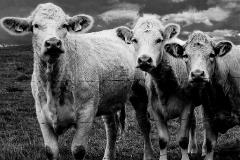Biosecurity Measures for Farms: Advice for Clients

An outbreak of an animal disease can be disastrous for those in the livestock industry. Lost sales and vanishing future sale opportunities can cause immense financial loss, and the damage caused to a professional reputation can create long-term personal stress and business hardship. In an effort to control potential outbreaks, farmers and production businesses need to work to remain infection and disease-free.
Approach
Biosecurity is a system of established management practices designed to prevent infectious agents from entering a farm.
Management
The plan for biosecurity begins with management. Preventing the introduction of infection requires establishing a protocol that determines and outlines specific steps to follow. Procedures that should be identified include, for example:
- Screening
- Outline the measures to screen and test every incoming animal
- Quarantine
- Provide a separate and identified area to quarantine and isolate newly purchased animals or animals returning to the farm
- Include steps for employees to follow to prevent the possibility of disease transfer and contamination of healthy livestock
- Monitor
- Devise a program that defines procedures to monitor and evaluate animals
- Biocontainment
- Design management practices to prevent the spread of infectious agents:
- Between animals
- From leaving the farm
- Establish a biocontainment plan in the event an infectious agent is discovered
Development
There are several initial steps to take in order to develop a biosecurity plan. Points to consider include the following:
- Assess the goals of the farm
- Determine which infectious agents could cause a problem and should be of concern
Based on the concerns, find out if federal or state regulations and plans have already been developed for use.
Assess Risks
Determining the areas of risk a disease poses to a farm involves assessing its:
- Presence
- Modes of distribution
- Level of severity
Steps to assess the disease include looking at:
- Products from the farm that are sold or plan to be sold in the future, for example:
- Meat
- Milk
- Breeding stock
- Embryos
- Learn how the disease affects the sale of the products
- Evaluate how the disease enters and spreads within the animal groups
- Determine methods to prevent the source of the disease from entering the farm
Level of Risk
Depending on the disease, there will typically be animals and areas that could be more susceptible to illness and have the increased potential to spread disease between animals and other farms. These areas are classified based on disease prevalence as:
- Low risk
- Example, farm office
- Moderate Risk
- Example: Tack room where equipment is cleaned, but shared
- High Risk
- Example: Housing areas of new animals or those returning to the farm
Focusing biosecurity efforts on identified risk levels and on the disease characteristics will help to customize a biosecurity plan that will focus on specific areas and activities to make the plan more effective.
Involvement
In order for a biosecurity plan to be effective, procedures need to be developed that are customized to the individual farm setting. Herd veterinarians typically work with farmers and producers to implement a plan, but the following people should also be involved to understand their importance in the development and maintenance of the farm’s biosecurity plan:
- Every person who works, visits, and lives at the farm.
Promoting the guidelines for biosecurity and taking the steps to minimize the chance for contamination by infected animals and/or infectious agents are important to the financial future of a farm.
Want to learn more farm biosecurity techniques? Contact your Covetrus representative today at 855.724.3461!
Information gathered from:
http://extension.psu.edu/animals/health/biosecurity/fundamentals/biosecurity-a-practical-approach
http://extension.psu.edu/animals/health/biosecurity/risk-assessment/livestock-exhibitions
Careers
Are you looking for a place to let your talents shine? At Covetrus, we help our practitioner customers better serve their patients and take pride in providing the best customer experience possible. Search our open positions to see our available opportunities.
Newsletter
Stay current with what’s going on with Covetrus, subscribe to receive our newsletter and email communications. Subscribers will receive the latest information in practice management, sales and marketing, animal health, and more.


Leave a comment